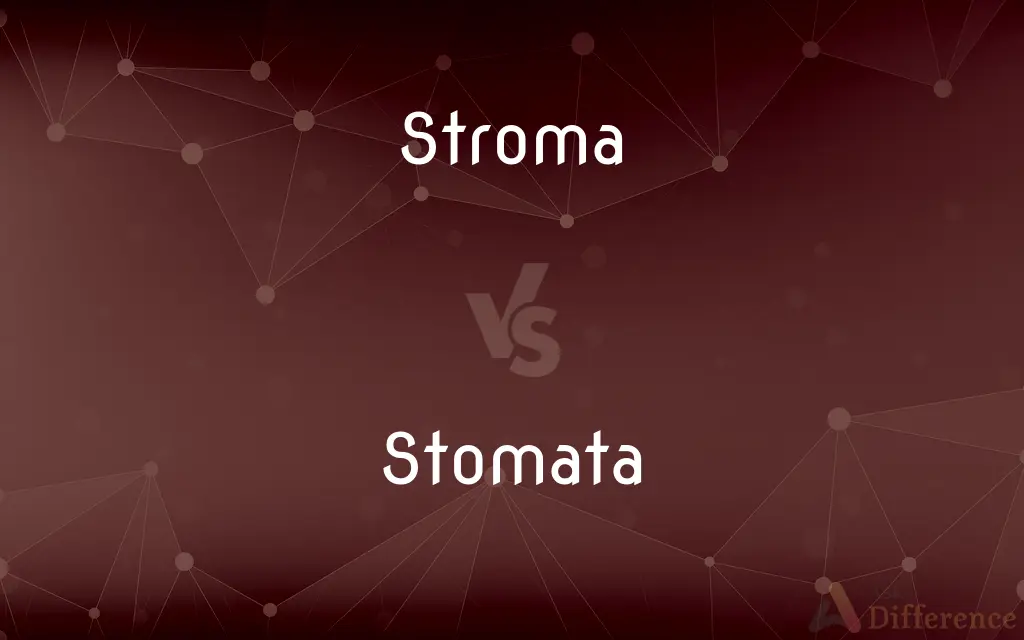Stroma vs. Stomata — What's the Difference?
By Tayyaba Rehman — Updated on October 3, 2023
Stroma refers to the matrix within chloroplasts where the Calvin cycle occurs, while stomata are microscopic pores on plant surfaces facilitating gas exchange.

Difference Between Stroma and Stomata
Table of Contents
ADVERTISEMENT
Key Differences
Embarking on understanding stroma and stomata involves delving into botany, focusing on plant physiology and cellular structures. Stroma carries a crucial role, particularly within chloroplasts, as it is the gel-like substance in which the dark phase of photosynthesis, namely the Calvin cycle, takes place. Contrastingly, stomata serve as an essential external feature, poised on the epidermis of plant leaves and stems, permitting the interchange of gases like carbon dioxide and oxygen with the environment.
Stroma, contained within the chloroplasts, harnesses both enzymatic function and the capacity to hold structures like thylakoids and grana, which are pivotal for the light phase of photosynthesis. Contrariwise, stomata, despite not being directly involved in photosynthesis, play an indirect, but vital role by regulating the influx of carbon dioxide, which is a substrate for photosynthesis, and the release of oxygen, a byproduct of the same process.
Digging deeper into stroma, this aqueous matrix not only houses enzymes for the Calvin cycle but also contains DNA and ribosomes, asserting its significance in protein synthesis and chloroplast biogenesis. In parallel, stomata are underscored by guard cells that regulate their opening and closing, ensuring that the plant can achieve optimal gas exchange while minimizing water loss, especially vital in arid conditions.
In a more molecular perspective, the stroma participates in synthesizing important molecules such as ATP and NADPH, which are indispensable for fueling the dark phase of photosynthesis. In contrast, stomata act as gatekeepers, adjusting the plant’s exposure to external atmospheric conditions, and modulating transpirational water loss, thus impacting nutrient uptake through the roots.
In an ecological context, stroma supports plant life by enabling the conversion of inorganic carbon into organic matter, propelling ecosystems. Conversely, stomata function in maintaining internal atmospheric stability in plants, adjusting to external environmental factors and ensuring physiological stability across varied environmental contexts.
ADVERTISEMENT
Comparison Chart
Location
Inside chloroplasts, surrounding thylakoid membranes
On plant surfaces, primarily on leaves
Biological Function
Facilitates the dark phase of photosynthesis, hosts enzymes
Allows gas exchange between the plant and external environment
Structural Components
Contains enzymes, DNA, and ribosomes
Composed of pores surrounded by guard cells
Role in Photosynthesis
Direct, facilitates the Calvin Cycle
Indirect, enables carbon dioxide influx and oxygen outflux
Interaction with Environment
Internally focused, does not interact directly with the external environment
Direct interaction with the external environment
Compare with Definitions
Stroma
An aqueous medium enveloping thylakoids in chloroplasts.
The grana are embedded within the stroma of the chloroplasts.
Stomata
Vital for transpiration in plants.
Through stomata, plants lose water via the process of transpiration.
Stroma
A matrix inside chloroplasts facilitating photosynthesis.
The stroma contains enzymes crucial for the Calvin cycle.
Stomata
Impact nutrient and water uptake through transpiration pull.
The opening of stomata influences the transpiration pull, affecting nutrient uptake.
Stroma
Involved in synthesizing ATP and NADPH during photosynthesis.
The synthesized ATP in the stroma fuels the dark phase of photosynthesis.
Stomata
Microscopic pores enabling gas exchange in plants.
The stomata allow the leaf to absorb carbon dioxide from the air.
Stroma
Hosts DNA and ribosomes for protein synthesis.
Within the stroma, specific proteins essential for photosynthesis are synthesized.
Stomata
Regulated by guard cells controlling their aperture.
The guard cells surrounding the stomata facilitate its opening and closing.
Stroma
Conducts the conversion of inorganic to organic carbon.
The stroma plays a pivotal role in synthesizing organic molecules during the Calvin cycle.
Stomata
Act as gateways for atmospheric interaction in plants.
Stomata ensure that plants maintain a balance between gas exchange and water retention.
Stroma
The connective tissue framework of an organ, gland, or other structure, as distinguished from the tissues performing the special function of the organ or part.
Stomata
A plural of stoma.
Stroma
The spongy, colorless framework of a red blood cell or other cell.
Stroma
The colorless semiliquid material inside a chloroplast, in which the thylakoid membranes are embedded and where the dark reactions of photosynthesis occur.
Stroma
A dense mass of fungal hyphae on or in which reproductive structures develop.
Stroma
(anatomy) The tissue structure of an organ, etc., that serves to support it.
Stroma
The connective tissue or supporting framework of an organ; as, the stroma of the kidney.
Stroma
A layer or mass of cellular tissue, especially that part of the thallus of certain fungi which incloses the perithecia.
Stroma
The dense colorless framework of a chloroplast
Stroma
The supporting tissue of an organ (as opposed to parenchyma)
Common Curiosities
What controls the opening and closing of stomata?
Guard cells regulate stomata's aperture.
Are stomata present in all plants?
Nearly all, as stomata facilitate essential gas exchange.
What is the primary function of stroma?
Stroma facilitates the Calvin cycle in photosynthesis.
Is stroma involved in ATP synthesis?
Yes, ATP synthesis during photosynthesis occurs in the stroma.
Can stroma function in the absence of light?
Yes, the Calvin cycle in stroma is light-independent.
Does stroma contain chloroplast DNA?
Yes, stroma hosts chloroplast DNA and ribosomes.
How do stomata contribute to transpiration?
Stomata allow water vapor to exit, facilitating transpiration.
Share Your Discovery

Previous Comparison
Cart vs. Buggy
Next Comparison
Readmittance vs. ReadmissionAuthor Spotlight
Written by
Tayyaba RehmanTayyaba Rehman is a distinguished writer, currently serving as a primary contributor to askdifference.com. As a researcher in semantics and etymology, Tayyaba's passion for the complexity of languages and their distinctions has found a perfect home on the platform. Tayyaba delves into the intricacies of language, distinguishing between commonly confused words and phrases, thereby providing clarity for readers worldwide.














































